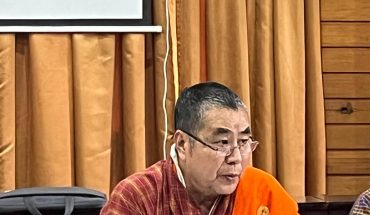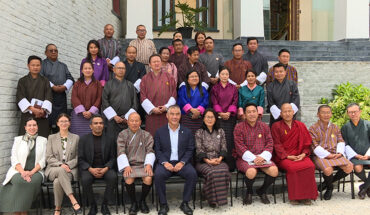
NGAWANG JAMPHEL
Thimphu
The Ministry of Finance (MoF) has advocated three key sectors development indicators for the fiscal year 2024-25 which includes electricity, tourism and labour markets.
These three key sectors will play a vital role in driving our economy and boosting economic growth.
As per data release by the MoF, hydropower generation as of 30th September 2024 stands at 8,843.9 MU as compared to the initial target of 8,511.8 MU, which is an increase of 4 per cent.
The total generation is anticipated to reach 10,900.7 MU and gradually increase to 14,830.5 MU in 2025 with the anticipated commissioning of PHPA-II by June 2025.
Similarly, the export revenue earning in 2025 will also decrease by 11.4 per cent as compared to the fourth quarter update. Given the surge in the domestic energy demand, the share of the domestic energy consumption from the total generation will increase from 51 per cent in 2023 to 71 per cent in 2025, leaving a mere 29 per cent for the export market.
Given such dynamics, the energy import bill is expected increase exponentially despite the commissioning of the PHPA-II in 2025
Therefore, investment in renewable energy, energy diversification, and energy security becomes crucial. More importantly, domestic energy consumption should result in domestic production and value-addition whose export value shall offset the energy consumed, otherwise meant for export.
With regard to tourism sector, as of 30th September 2024, total tourist arrival was around 95,633, which is 46 per cent of the arrival in 2019 during the same period.
Of these total arrivals, 68 per cent were Indian nationals while the remaining 32 per cent were tourists of other nationalities. In the third quarter of 2024, the total tourist arrival was 20,025, of which Indian arrival was 12,052. Based on the government’s tourist arrival target of 150,000 in 2024, about 64 per cent has been achieved as of 30th September.
However, with government interventions aimed at promoting and attracting tourists through marketing, access to regional gateways, and skilling programs in the hospitality sector, it is anticipated that the tourist arrival will reach the pre-pandemic level by 2027.
Tourism is an important sector for Bhutan’s economy as it has significant upstream and downstream linkages. Given the low diversity of current economy, it is important for the tourism sector to expedite the recovery to bolster economic growth and generate employment opportunities.
However, since the market is anticipated to recover only in 2027, it may hinder the ambitious growth target set under 13th FYP for the overall economy.
With regard to the labour market, the number of employed individuals across various sectors decreased to 355,416 in the second quarter of 2024, down from 368,048 in the 1st quarter.
A significant part of this decline is due to a reduction in employment within the manufacturing sector, which saw a drop of 7,652 jobs from the 1st quarter.
The remaining decline in employment of 4,980 jobs is attributed to sectors other than the manufacturing sector. Short-term fluctuations in employment may also be influenced by seasonal factors.
In the previous quarter, total employment by sectors projection was 361,732 based on the average of the first two quarters. The projection for this quarter has increased to 367,495 reflecting the average of the three quarters. Total employment has increased from 355,416 in the last quarter to 379,022 in the current quarter.
This growth is primarily driven by significant gains in the agriculture and forestry, construction, wholesale and retail trade, and transport and communications sectors.
Although some sectors experienced a decline in employment, these decreases were outweighed by the substantial growth in the key sectors mentioned, resulting in an overall rise in employment.
In the last quarter update, the unemployment rate for 2024 was projected at 3.9 per cent based on the average of the first two quarters. However, with the inclusion of data from the third quarter, the projection has been revised to 3.6 per cent for the year.
The unemployment rate for the current quarter stands at 3.1 per cent bringing the overall unemployment rate at 3.6 per cent. The unemployment rate has decreased by 0.6 percentage points from 3.7 per cent to 3.1 per cent.
Unemployment is higher among females with 4.2 per cent than males with 2.4 per cent and is more prevalent in urban areas with 5.1 per cent compared to rural areas with 2.1 per cent.
According to the 1st quarter update of FY 2024-25, the overall unemployment rate for 2024 is estimated at around 3.6 per cent. With the start of plan period and significant government investment, unemployment is expected to decrease over the years.
Total youth unemployment rate has dropped by 2.7 percentage-points from the previous quarter from 19.2 per cent to 16.5 per cent. Youth unemployment rate is higher for females with 21.8 per cent than males with 11.9 per cent.
Additionally, youth unemployment is primarily an urban issue, with a rate of 20.1 per cent in urban areas versus 13.8 per cent in rural areas.
With delay in commissioning of PHPA-II and slow recovery of tourism sector, the fiscal position is likely to worsen if such events continue at current rate.
Further, with decline in real wage growth for public administration, there can be further pressure to increase it resulting in further deterioration of fiscal position.
Overall, Bhutan’s economy is expected to grow at an average annual rate of 7.0 per cent in the medium term, slightly below the 8 percent target for the 13th FYP.
Achieving the vision of a high-income economy will require improving the efficacy of fiscal spending, boosting productivity in agriculture, and diversifying the economy beyond hydropower and tourism.
The recovery of tourism industry to pre-pandemic level is particularly critical, as it will stimulate consumption demand for goods and services produced within the economy, especially by agriculture and manufacturing sector.





